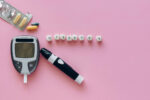Facts About Diabetes
- People with diabetes can get too high or low blood sugar in a short period of time – both of them require quick help from the environment
Too low blood sugar
- May cause increased sweat, cold, clumsy and pale skin, strong pulse and palpitation, hunger and weakness.
- The person may be confused and respond badly to the charge, and sometimes faint and get seizures similar to epilepsy
Too high blood sugar
- May cause dry skin and a deep, heavy breathing and rapid pulse.
- The person’s breath can smell acetone (nail polish remover) and he / she can be very thirsty, be unclear and confused and rarely lose consciousness
- If the person is angry or unconscious call a medical centre
Background
- A person with diabetes is unable to produce the right amount of insulin
- Insulin is a hormone that controls how much sugar is in the blood
- Too much insulin causes an abnormally low blood sugar (hypoglycaemia)
- Insufficient insulin causes an abnormally high blood sugar (hyperglycaemia)
- Both modes can be serious
First aid in case of unclear diagnosis
- As a starting point, it can be difficult to determine if the patient has too high or too low blood sugar
- If the person feels uncomfortable and you know he / she has diabetes, you can give something sweet to drink, eg apple juice or sweet juice
- This will quickly correct a low blood sugar and it will not cause harm if the person has high blood sugar
First aid on unconsciousness
- Ensure free airways and check that the person breathes
- Put the person in sideways if he / she breathes
- Get ready for resuscitation if necessary
- Call ambulance
- Record regular vital functions such as degree of response (awareness), breathing and pulse until help reaches
Too low blood sugar (hypoglycaemia)
Typical symptoms and signs
- Appears primarily in patients who use insulin, but can also be seen in patients receiving tablets of the sulphonylurea group (eg gliclazide, glibenclamide) for their diabetes
- Sweat – cold, damp and pale skin
- Strong pulse and palpitation
- Hunger, weakness, can faint
- Confusion and responding badly to accusation
- Surface breathing
- May have seizures similar to epilepsy
First aid
- Give sugary drinks or food
- Ask the person to sit down
- Give a drink or something sweet to eat
- Ask them to relax
- When the person starts to feel better, you can give more food or drink
- He must take it easy
- The patient should be able to talk with his doctor about the treatment
Too high blood sugar (hyperglycaemia)
Typical symptoms and signs
- Person with diabetes, especially among people who use insulin, but can also be seen in patients who receive tablets for their diabetes
- Dry skin
- Deep, heavy breathing. Fast pulse
- The breath of the person can smell acetone (same smell as nail polish remover)
- Extreme thirst
- The person may be unclear and confused and may rarely lose consciousness
First aid
- Possibly give something sweet to drink or eat if you are unsure of the diagnosis
- Call 112 and call ambulance
- Record regular vital features such as degree of response (awareness), breathing and pulse until help reaches

